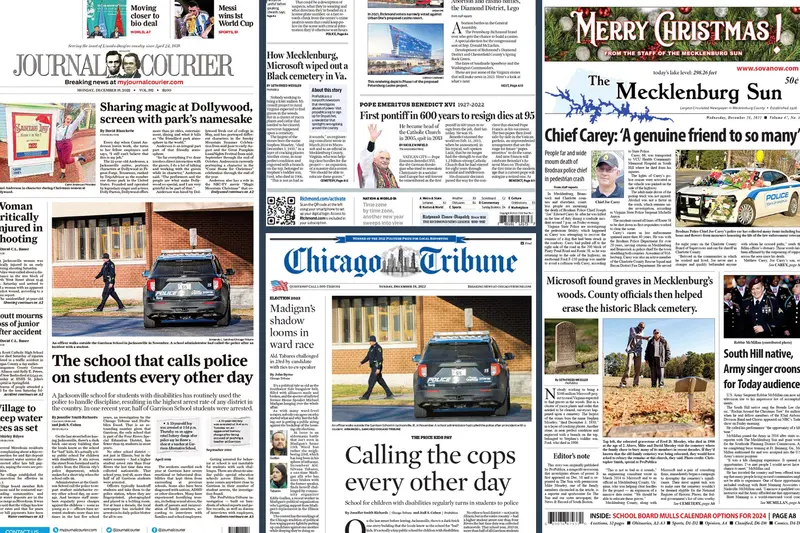The smart Trick of News Articles That Nobody is Talking About
The smart Trick of News Articles That Nobody is Talking About
Blog Article
The Basic Principles Of News Articles
Table of ContentsNot known Factual Statements About News Articles Excitement About News Articles3 Simple Techniques For News ArticlesIndicators on News Articles You Should KnowSome Known Details About News Articles
Good knowledge of various topics offers students an affordable side over their peers. Despite the fact that digital and social media sites are easily obtainable, we ought to not fail to remember just how essential it is to read the newspapers. Moms and dads must try and instill the practice of checking out a paper as an everyday regimen to continue the tradition of the adored print medium.Information stories likewise have a minimum of among the following vital qualities about the desired target market: distance, importance, timeliness, human passion, strangeness, or effect. The associated term journalese is sometimes used, generally pejoratively, to refer to news-style writing. An additional is headlinese. Papers typically follow an expository writing design.
Within these restrictions, newspaper article additionally aim to be comprehensive. Various other elements are involved, some stylistic and some obtained from the media form. Among the bigger and extra highly regarded newspapers, justness and equilibrium is a major factor in providing details. Discourse is generally constrained to a different area, though each paper may have a different general angle.
Papers with a worldwide audience, for example, often tend to utilize a more formal design of creating. News Articles.; common design overviews include the and the United States News Design Book.
The smart Trick of News Articles That Nobody is Discussing
As a guideline, journalists will not make use of a lengthy word when a brief one will do. News authors attempt to prevent using the very same word extra than when in a paragraph (often called an "echo" or "word mirror").
Headings often omit the topic (e.g., "Jumps From Watercraft, Catches in Wheel") or verb (e.g., "Pet cat lady fortunate"). A subhead (likewise subhed, sub-headline, subheading, subtitle, deck or dek) can be either a subordinate title under the major headline, or the heading of a subsection of the article. It is a heading that comes before the primary text, or a group of paragraphs of the main message.

Extra signboards of any of these types may show up later on in the short article (especially learn the facts here now on succeeding pages) to attract further analysis. Such signboards are also used as reminders to the post in various other areas of the publication or website, or as promotions for the item in various other magazine or sites. Normal framework with title, lead paragraph (recap in bold), other paragraphs (details) and call information.

Instance of a hard-lead paragraph NASA is click for source recommending one more space job. The budget requests approximately $10 billion for the job.
An "off-lead" is the second most vital front web page information of the day. To "bury the lead" is to start the short article with history details or information of secondary relevance to the readers, forcing them to read more deeply into a post than they must have to in order to uncover the necessary points.
The 45-Second Trick For News Articles
Usual usage is that a person or two sentences each form their very own paragraph. Journalists normally describe the company or structure of a newspaper article as an upside down pyramid. The vital and most interesting components of a story are placed at the start, with supporting details adhering to in order of lessening relevance.
It allows people to explore a subject to only the deepness that their interest takes them, and without the imposition of details or nuances that they could consider unimportant, however still making that information readily available to much more interested readers. The inverted pyramid structure also makes it possible for short articles to be trimmed to any approximate size during layout, to fit in the area readily available.
Some writers find out here start their tales with the "1-2-3 lead", yet there are numerous type of lead readily available. This format usually starts with a "5 Ws" opening up paragraph (as defined above), complied with by an indirect quote that offers to support a significant element of the very first paragraph, and after that a straight quote to support the indirect quote. [] A kicker can refer to numerous points: The last story current program; a "pleased" story to end the show.
Longer write-ups, such as publication cover write-ups and the pieces that lead the within areas of a paper, are recognized as. Function stories differ from straight information in several ways.
The Greatest Guide To News Articles
The reporter commonly details interactions with interview topics, making the item extra personal. A feature's initial paragraphs usually relate an interesting moment or event, as in an "anecdotal lead". From the particulars of an individual or episode, its sight quickly widens to generalizations about the story's topic. The area that signals what an attribute has to do with is called the or billboard.
The Editor's Toolbox: A Reference Overview for Beginners and Professionals (2001) Allan M. Siegal and William G. Connolly. The New York Times Handbook of Design and Use: The Official Style Guide Utilized by the Writers and Editors of the World's The majority of Reliable Newspaper (2002) M. L. Stein, Susan Paterno, and R.
Report this page